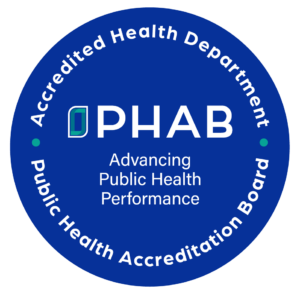Tracking & Preventing the
Spread of Communicable Diseases
The Union County Health Department’s communicable disease team works to prevent, identify, and mitigate outbreaks of infectious diseases within Union County. The team of epidemiologists and public health nurses monitor disease trends, do disease investigations and contact tracing, issue health alerts and provide infection control guidance to patients, affected worksites or community locations, and healthcare providers.
For Healthcare Providers & Medical Professionals
Per the Ohio Revised Code, certain infectious diseases are required to be reported to the local health department within specified time periods. Healthcare providers and laboratories can use the State of Ohio’s Quick Guide to Reportable Infectious Diseases or the Ohio Infectious Disease Control Manual to determine reporting requirements. Suspected or confirmed reportable diseases can be submitted online, by fax or by phone.

Call 937.642.2053 Monday through Friday 8 am-4 pm and state you are reporting a communicable disease. If after hours and reporting a class A disease, call the Union County Sheriff’s Office Dispatch Center at 937-645-4110 and ask for the on-call Health Department staff member.
Reporting Requirements
Class A Reportable Diseases
Diseases of major public health concern because of the severity of disease or potential for epidemic spread – report immediately via telephone upon recognition that a case, a suspected case, or a positive laboratory result exists.
- Anthrax
- Botulism, foodborne
- Cholera
- Diphtheria
- Influenza A – novel virus infection
- Measles
- Meningococcal disease
- Middle East Respiratory Syndrome (MERS)
- Plague
- Rabies, human
- Rubella (not congenital)
- Severe acute respiratory syndrome (SARS)
- Smallpox
- Tularemia
- Viral hemorrhagic fever (VHF), including Ebola virus disease, Lassa fever, Marburg hemorrhagic fever, and Crimean-Congo hemorrhagic fever
Any unexpected pattern of cases, suspected cases, deaths or increased incidence of any other disease of major public health concern, because of the severity of disease or potential for epidemic spread, which may indicate a newly recognized infectious agent, outbreak, epidemic, related public health hazard or act of bioterrorism.
Class B Reportable Diseases
Disease of public health concern needing timely response because of potential for epidemic spread – report by the end of the next business day after the existence of a case, a suspected case, or a positive laboratory result is known.
- Amebiasis
- Arboviral neuroinvasive and non-neuroinvasive disease:
- Chikungunya virus infection
- Eastern equine encephalitis virus disease
- LaCrosse virus disease (other California serogroup virus disease)
- Powassan virus disease
- St. Louis encephalitis virus disease
- West Nile virus infection
- Western equine encephalitis virus disease
- Yellow fever
- Zika virus infection
- Other arthropod-borne diseases
- Babesiosis
- Botulism
- infant
- wound
- Brucellosis
- Campylobacteriosis
- Candida auris
- Carbapenemase-producing carbapenem-resistant Enterobacteriaceae (CP-CRE)
- CP-CRE Enterobacter spp.
- CP-CRE Escherichia coli
- CP-CRE Klebsiella spp.
- CP-CRE other
- Chancroid
- Chlamydia trachomatis infections
- Coccidioidomycosis
- Creutzfeldt-Jakob disease (CJD)
- Cryptosporidiosis
- Cyclosporiasis
- Dengue
- E. coli O157:H7 and Shiga toxin-producing E. coli (STEC)
- Ehrlichiosis/anaplasmosis
- Giardiasis
- Gonorrhea (Neisseria gonorrhoeae)
- Haemophilus influenzae (invasive disease)
- Hantavirus
- Hemolytic uremic syndrome (HUS)
- Hepatitis A
- Hepatitis B (non-perinatal)
- Hepatitis B (perinatal)
- Hepatitis C (non-perinatal)
- Hepatitis C (perinatal)
- Hepatitis D (delta hepatitis)
- Hepatitis E
- Influenza-associated hospitalization
- Influenza-associated pediatric mortality
- Legionnaires’ disease
- Leprosy (Hansen disease)
- Leptospirosis
- Listeriosis
- Lyme disease
- Malaria
- Meningitis:
- Aseptic (viral)
- Bacterial
- Mumps
- Pertussis
- Poliomyelitis (including vaccine-associated cases)
- Psittacosis
- Q fever
- Rubella (congenital)
- Salmonella Paratyphi infection
- Salmonella Typhi infection (typhoid fever)
- Salmonellosis
- Shigellosis
- Spotted Fever Rickettsiosis, including Rocky Mountain spotted fever (RMSF)
- Staphylococcus aureus, with resistance or intermediate resistance to vancomycin (VRSA, VISA)
- Streptococcal disease, group A, invasive (IGAS)
- Streptococcal disease, group B, in newborn
- Streptococcal toxic shock syndrome (STSS)
- Streptococcus pneumoniae, invasive disease (ISP)
- Syphilis
- Tetanus
- Toxic shock syndrome (TSS)
- Trichinellosis
- Tuberculosis (TB), including multi-drug resistant tuberculosis (MDR-TB)
- Varicella
- Vibriosis
- Yersiniosis
Class C Reportable Diseases
Report an outbreak, unusual incident or epidemic of other diseases (e.g. histoplasmosis, pediculosis, scabies, staphylococcal infections) by the end of the next business day.
Outbreaks:
- Community
- Foodborne
- Healthcare-associated
- Institutional
- Waterborne
- Zoonotic
Cases of AIDS (acquired immune deficiency syndrome), AIDS-related conditions, HIV (human immunodeficiency virus) infection, perinatal exposure to HIV, all CD4 T-lymphocyte counts and all tests used to diagnose HIV must be reported on forms and in a manner prescribed by the Director.
Click to download the quick guide to reportable infectious diseases.
Communicable Disease Team
Mary Salimbene Merriman:
Epidemiologist | 937.645.2062
Josh Moore:
Epidemiologist | 937.645.2028

